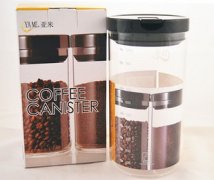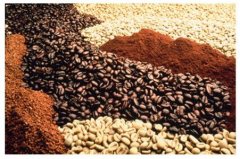How to Make a Good Coffee with Coffee Grind
We often say that drinking coffee requires a good cup of coffee, but making a good cup of coffee is inseparable from the three steps of roasting coffee beans, grinding coffee beans, and brewing coffee powder, and these three keys are "freshness".
Therefore, it is important that coffee be preserved as beans as possible and ground before extraction. Next, let's talk about what kind of grinder to use for coffee grinding and how to grind it. The correct way to grind coffee beans is not just to put the beans into the grinder to grind coffee powder. For the performance of the grinder and the grinding degree of coffee powder, we must fully understand, we must first conceive in the brain what kind of coffee powder to extract, but also pay attention to the preservation of the remaining coffee powder, taking into account these can be called the correct grinding method.
The four main points of coffee bean grinding are summarized as follows:
1. Coffee grinding degree should be average------make coffee more delicious
The word "average" will run through the whole process of coffee roasting and coffee making. One of the big problems in roasting is how to make the green bean size and water content "average". When it comes to coffee grinding, the emphasis is on how to make coffee grind evenly.
If the coffee grinding is uneven, it will cause the coffee taste is not uniform, not coordinated, no matter which step, must reduce the uneven situation to a minimum, the pursuit of no miscellaneous taste, homogeneous and balanced taste of coffee. Whether the coffee particles after grinding are uniform will directly affect whether the coffee extract is homogeneous. In other words, uneven coffee grinding will make the concentration of coffee uneven.
So, how does the difference in grinding degree affect the taste of coffee?
There is a constant rule in coffee grinding: the finer the coffee is ground, the more bitter the coffee is, and the coarser the coffee is ground, the less bitter the coffee is.
The reason is simple: fine ground coffee powder has a larger surface area and more extracted components. The more soluble components in coffee, the stronger the bitterness. Coarse ground coffee, on the other hand, has a smaller surface area, less extracted ingredients, and the bitterness of coffee out of the cup is weaker. Of course, it should be mentioned here that the lower the concentration of coffee, the less bitter it is. The bitterness is weaker, and instead the sourness of the coffee becomes stronger.
Take this basic law and coffee grinding to average contrast, if the grinding degree of coffee powder mixed together, the concentration of soluble components in coffee will be inconsistent, sour and bitter will be extracted, you can imagine how this cup of coffee will become a cup of turbid and miscellaneous liquid.
Therefore, coffee grinds evenly and is one of the conditions that make our coffee more delicious.
2. How to reduce the heat generated when grinding beans
We all know that friction heat is inevitable when grinding coffee with a coffee grinder. Whether it's coffee or wheat, it's normal for heat to be generated during grinding. The reason for this is that heat can obviously damage the taste and aroma of coffee. Therefore, choosing a suitable grinder is also crucial.
Much attention has been paid to the fact that coffee produces heat when ground. Experts believe that under very ordinary speed and load conditions, the instantaneous high temperature generated by friction in local areas of the metal surface can reach 500 degrees to 1000 degrees.
It is inevitable that coffee will produce heat when grinding, but depending on the structure of the grinder, the heat will also vary.
There are two ways to grind coffee beans. One is to grind coffee beans with two grooved disc blades. This type of grinder is called a grinding grinder. Most manual grinders belong to this type. The other is represented by a shredding grinder, which cuts coffee beans by two sets of rollers with sharp edges that are perpendicular to each other. This method is called a cutting grinder. Common electric bean grinder is such.
Many people generally believe that grinding slowly with a hand grinder does not generate heat. In fact, on the contrary, the type of disc blade friction tends to generate heat. Alternatively, a cutter grinder minimizes frictional heat from grinding coffee. Because grinding produces frictional heat, chopping beans produces almost no heat.
The advantages and disadvantages of comparing manual bean grinder with electric bean grinder are as follows:
Advantages and disadvantages of manual grinding machine:
1. The ground coffee powder is easy to be uneven.
2, easy to generate friction heat
3. Very little fine powder is produced
Advantages and disadvantages of electric bean grinder:
1. Average ground coffee particles
2, not easy to produce friction heat
3, easy to produce fine powder
Looking at the comparative analysis of the above two kinds of bean grinders often makes it more difficult for us to make a choice about the bean grinder. In fact, for our families, we often don't have to struggle with these small places. If the beans are ground before drinking, it doesn't matter which grinder you use.
These small areas fall into the category of coffee manufacturers to consider. Most established coffee makers use grinders that don't generate frictional heat because their customers are people who don't know when to finish their coffee. So coffee makers need to pay more attention to the choice of coffee grinders.
3, can not produce fine powder
Coffee grinds produce coffee fines to some extent. Fine powder has a worse effect on coffee than the heat generated by grinding machine friction, which not only makes coffee cloudy, but also brings unpleasant bitterness and astringency. The effect of fine powder is that the high-temperature charged coffee fine powder directly adheres to the inside of the grinder, and after rancidity, it is mixed into the new coffee at the next grinding.
The trick is to choose a grinder that doesn't produce coffee fines as much as possible, or to carefully brush off the fines with the included brush every time the grinder is used. These are emergency disposal methods. In short, cleaning the bean grinder is a must.
Coffee grinding degree using coarse, and powder amount than usual 20 to 30%, coupled with drip filter slowly extracted, so that the taste is obviously more stable, and more mellow feeling, can make excellent flavor of coffee, just increase the thickness of the coffee powder filter layer, can extract more delicious ingredients, which is fine ground coffee can not do.
Coffee powder doped with fine powder will brew a strong coffee with obvious astringency. Coarse grinding, then you can brew coffee that is not turbid and tastes fresh. We use techniques that do not produce fines in the brewing process to make our coffee tastier and more mellow.
4. Select the grinding degree suitable for extraction method
The fourth of the four points of coffee bean grinding will be shared below: Choose the grinding degree suitable for coffee utensils.
Here I would like to remind you that "the finer the bitterness, the stronger the bitterness, the coarser the bitterness of the ground beans", this is the basic rule that remains unchanged in the coffee extraction process, which is caused by the different size of the coffee powder surface area covered by hot water.
Espress coffee, for example, grinds deeply roasted beans finely and extracts a small amount of coffee liquid in a short time using an espresso machine to get coffee with a fairly strong bitterness. What about the same coffee powder extracted by drip filtration? As you can see by doing it, the filter paper will be clogged with coffee powder, making it difficult for the injected hot water to pass through, the extraction time will be prolonged, and finally it will become excessive extraction.
So, is ultra-coarse ground coffee better?
The above problem is also a matter of degree. If the grinding is too coarse, the hot water will easily pass through the filter paper, and the delicious ingredients of coffee will not be fully extracted. In this way, the coffee obtained from the coffee pot becomes a light, thin liquid.
Each coffee maker has its own grind, so grinding is not what we want to grind with what grind. As mentioned above, the method of making coffee by drip filter is not suitable for coffee powder too coarse or too fine, that is to say, the most suitable grinding degree is medium to medium coarse.
The following is the relationship between the grinding degree of coffee powder and the extraction method:
1, suitable for fineness grinding: Turkish copper pot, mocha pot, espresso machine.
2, suitable for moderate grinding: filter paper drip method, flannel drip method, plug pot (also known as siphon pot).
3, suitable for coarse grinding: drip coffee machine, drip pot.
TIPS: By the way, a Turkish copper pot shaped like a ladle is filled with coffee powder, water and sugar and boiled over a fire. This method of extracting coffee, known as the "poaching method," uses a finely ground coffee powder that is deeply roasted. Why use dark roasted coffee powder? Light and medium roast coffee powder will increase its astringency after boiling at high temperature, while the use of deep roast coffee, even if extracted at high temperature, will result in a completely bitter coffee.
Why do espresso machines make coffee with dark roast beans?
Espresso vs. Turkish Coffee There is another reason to use dark roast coffee. Because deep roasting will make coffee beans soft and easy to grind a little bit finer. It's a bit superfluous, but some Italian-made grinders can't grind light roasted hard coffee beans. The grinder was originally designed for dark roast coffee beans, and grinding hard, light roast coffee beans would immediately malfunction. It seems that the performance of the bean grinder also represents the personality of the country.
Important Notice :
前街咖啡 FrontStreet Coffee has moved to new addredd:
FrontStreet Coffee Address: 315,Donghua East Road,GuangZhou
Tel:020 38364473
- Prev

How to preserve coffee beans
We should know what is the enemy of coffee bean preservation, such as high temperature, humidity, oxygen and sunlight. Coffee beans are more durable than coffee powder, so we should maintain the principle of "getting on the sedan chair and piercing the eyes now" when grinding coffee. So where are the coffee beans suitable for storage? Sealed storage tanks for coffee beans are a good choice. There are two kinds of metal and plastic, the latter is cheaper.
- Next

The method of roasting coffee beans with manual filter
First, prepare 100 grams of raw coffee beans, if there are broken coffee beans, remove them. Then put the raw coffee beans in the filter, close the lid, open the gas to medium fire, hold the filter about 20-30 centimeters above the gas, swing it in a round way, and bake patiently.
Related
- Guji coffee producing area of Guji, Ethiopia: Humbela, Shakiso, Wulaga
- What is the most expensive variety of Qiloso in BOP multi-variety group?
- How to store the coffee beans bought home?
- Why are Yemeni coffee beans so rare now?
- Ethiopian Sidamo all Red Fruit Sun Sun Santa Vini Coffee beans
- SOE is mostly sour? What does it mean? Is it a single bean? what's the difference between it and Italian blending?
- Is Italian coffee beans suitable for making hand-brewed coffee?
- How to choose coffee beans when making cold coffee? What kind of coffee beans are suitable for making cold coffee?
- Just entered the pit to make coffee, what kind of coffee beans should be chosen?
- Can only Japan buy real Blue Mountain Coffee? What are authentic Jamaican Blue Mountain coffee beans?

